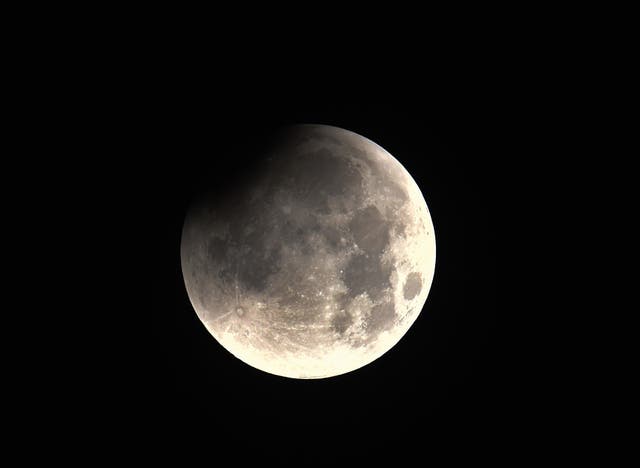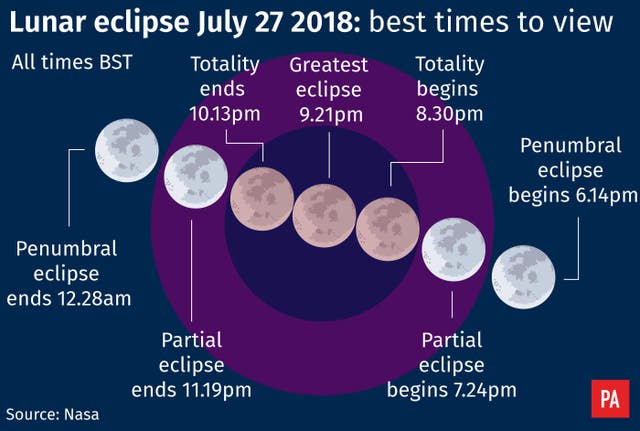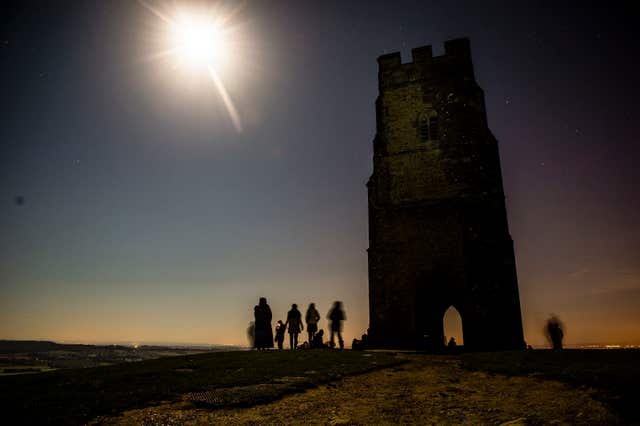
The longest lunar eclipse of the century is set to take place on Friday and will see the Earth’s natural satellite turn blood red.
The celestial event, where the moon will line up with the Earth and sun, will be seen over Glasgow, and across the UK, as well as other parts of the Eastern hemisphere.
Here’s everything you need to know about the astronomical phenomenon:
What exactly is a blood moon?
 (Yui Mok/PA)
(Yui Mok/PA)
During the eclipse the moon is expected to take on a red sheen, with the phenomenon being described as the “blood moon”.
As Dr Gregory Brown, an astronomer at the Royal Observatory Greenwich, explains: “At this time, the moon passes into the shadow of the Earth, blocking the light from the sun.
“However instead of turning black as you might expect, the atmosphere of the Earth bends the light of the sun onto the moon causing it to turn a deep red colour, hence this event’s somewhat ominous moniker.”
Why is it so special?
 (Owen Humphreys/PA)
(Owen Humphreys/PA)
The lunar eclipse will be the longest in the 21st century, expected to last 103 minutes.
However, those living in the UK and Ireland will not be able to see the start of the lunar eclipse as the moon will still be below the horizon.
Dr Brown said: “While more common than the solar eclipse, the event is nonetheless fairly unusual, with even partial eclipses rarely happening more than once or twice per year and each is only visible from a portion of the Earth.”
Mars will add to the spectacle shining brightly below the blood moon as it reaches perihelic opposition – where the Red Planet and the sun are on directly opposite sides of Earth.
And those awake after 11pm will be able to catch a glimpse of the International Space Station (ISS), as it moves quickly across the sky from west to east. It will appear like a bright star, before fading from sight a few minutes later.
What’s the weather going to be like?
A yellow weather warning for #thunderstorm has been updated: https://t.co/QwDLMfRBfs Stay #weatheraware @metofficeuk” pic.twitter.com/wpz5SqkkEX
— Met Office (@metoffice) July 25, 2018
Rainclouds and thunderstorms could prevent skygazers from seeing the eclipse in some parts of the UK.
The Met Office has issued a thunderstorm warning from Friday afternoon that is expected to last until midnight.
Torrential downpours are forecast in places, with as much as 30mm expected to fall in just an hour and 60mm in three hours.
Met Office spokesman Grahame Madge said: “It’s quite tricky at the moment to be precise but there is a potential for showers to develop across the eastern half of the UK.
“There may be large areas where the sky is effectively covered by thunderclouds.
“They will move through reasonably quickly but if that coincides with the peak moment of the eclipse, they could obscure the moon.”
When is the best time to watch it in Glasgow?

For those lucky enough to have clear skies, moonrise will be at 8.49pm in London, 9.46pm in Glasgow, 9.02pm in Cardiff and 9.27pm in Belfast, with mid-eclipse occurring at 9.21pm and the “total” phase ending at around 10.13pm.
Dr Brown said: “The eclipse will already be under way when the moon rises above the south eastern horizon at about 8.50pm and the total eclipse will end by about 10.15pm.
“From that point onwards, the shadow of the Earth will slowly retreat across the lunar surface until the partial eclipse comes to completion.
“The moon will remain in a very faint penumbral shadow for about an hour after that, but this is typically too light a shadow for the naked eye to notice the difference between that and the full moon that follows.”
Where is the best place to see the eclipse?
 People watch a blood red supermoon in the skies above Glastonbury Tor (Ben Birchall/PA)
People watch a blood red supermoon in the skies above Glastonbury Tor (Ben Birchall/PA)
According to Mr Madge, Wales, the south and west of England and most of Northern Ireland should have clear skies.
And for those living in thunderstorms warning areas hoping to catch a glimpse of the eclipse, he says having a clear night sky could be down to luck.
Mr Madge said: “The thunderstorms will be quite widespread but not necessarily close together and it’s going to be down to fortune whether people in certain locations are able to see this astronomical spectacle.”
Unlike a solar eclipse, the lunar event can be viewed without wearing protective eye gear.
Dr Brown said: “As the entire eclipse will occur when the moon is fairly close to the horizon, the main thing to ensure is that you have a clear sightline to the south east.
“Try to find an open space or high hilltop clear of trees and tall buildings around you.”


Comments & Moderation
Readers’ comments: You are personally liable for the content of any comments you upload to this website, so please act responsibly. We do not pre-moderate or monitor readers’ comments appearing on our websites, but we do post-moderate in response to complaints we receive or otherwise when a potential problem comes to our attention. You can make a complaint by using the ‘report this post’ link . We may then apply our discretion under the user terms to amend or delete comments.
Post moderation is undertaken full-time 9am-6pm on weekdays, and on a part-time basis outwith those hours.
Read the rules here